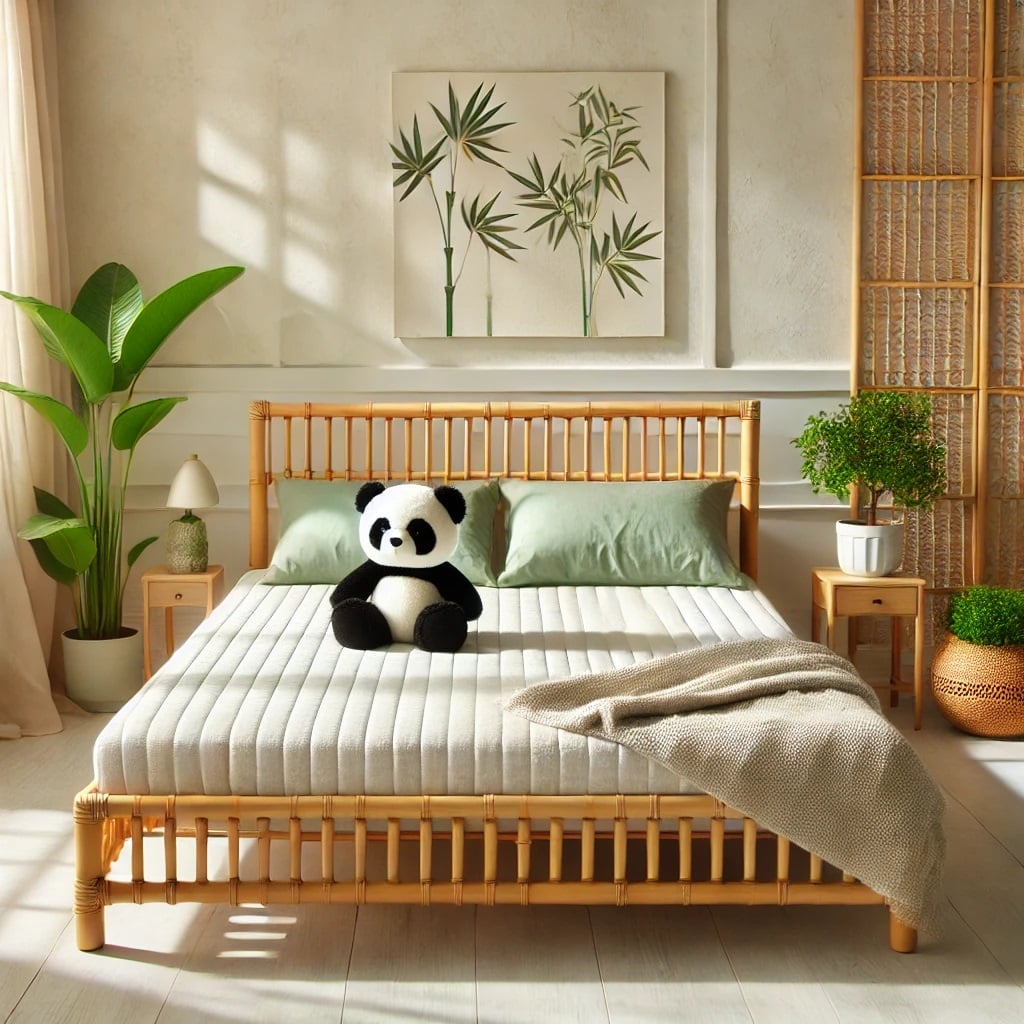Mattress shopping can get frustrating fast—especially when everything feels either too hot, too stiff, or made with who-knows-what. That’s one reason people are turning to bamboo mattresses instead. They give you a cooler, comfier night’s sleep using materials that are easier on both your body and the planet. If you’re tired of waking up sweaty, stiff, or sneezing, it might be time to try something different.
In this guide, I’ll walk you through the real benefits of bamboo mattresses—what makes them stand out, who they’re best for, and why they’ve become such a popular alternative to traditional foam or spring beds.
What You’ll Find Here
1. They Help You Sleep Cooler
Do you tend to overheat at night? Bamboo mattresses are known for their breathable covers, which can help with airflow and cooling. But keep in mind—the cooling effect also depends on what’s inside the mattress, like the foam or latex layers beneath the cover. The structure allows air to flow through, so your body stays cooler as you sleep. This can make a big difference if you tend to wake up hot and restless.
Example: If you’ve ever tossed off the covers at 3 a.m. just to cool down, this kind of airflow might be exactly what you need.
2. Gentler on Sensitive Skin and Allergies
If your skin reacts to harsh materials or you deal with sneezing in the morning, bamboo fibers might help. They naturally resist dust mites, mold, and other common allergens. Plus, they feel smoother and softer against your skin—less rubbing, less irritation.
Real-life perk: Waking up without that scratchy throat or itchy patches makes your whole morning routine easier. If skin sensitivity is a big concern for you, it’s also worth reading about how bamboo sheets help with sensitive skin—they can complement your mattress choice really well.
3. A Sustainable Choice Without Sacrificing Comfort
Bamboo grows fast, doesn’t need pesticides, and uses less water. That makes it a smart choice if you care about your environmental impact. Choosing a bamboo mattress means you’re using a fast-growing, renewable resource—just keep in mind that the process of turning bamboo into soft fabric often involves chemicals. That’s why it’s worth looking for brands that follow eco-conscious manufacturing and list their certifications clearly.
4. Designed to Last Longer
You don’t want your mattress sagging after a year. Bamboo mattresses tend to hold their shape well, especially when paired with quality support layers. With simple care, they can last 8 to 10 years or more. That’s a solid investment.
Tips to make it last even longer:
- A simple mattress cover can help protect the surface from everyday spills and wear
- Rotate it every few months
- Clean according to the care label
Mistake to avoid: Don’t fold or drag it without support—it can damage the structure over time.
5. Support That Adjusts to Your Sleep Style
Whether you sleep on your back, side, or stomach, a bamboo mattress tends to contour gently to your body. It helps relieve pressure without that sinking feeling. Some versions even offer two-sided firmness, which is great if your needs change.
And if you share your bed with a partner, you’ll likely notice less motion transfer. So if one of you tosses and turns, the other can keep sleeping soundly.
Comparison tip: Foam mattresses are known for excellent motion isolation, especially memory foam. Bamboo mattresses can still offer a calm sleep surface, but how well they isolate movement mostly depends on the mattress core, not the bamboo material itself.
6. Low Maintenance, High Payoff
Bamboo resists moisture, so it stays fresher longer. Many bamboo mattresses have removable covers you can wash, which helps with upkeep. And if you’ve dealt with lingering odors or musty foam before, you’ll likely notice a cleaner feel with bamboo.
Adding a mattress protector helps prevent stains, and rotating your mattress every few months keeps it in good shape. These small efforts stretch out the lifespan without much hassle.
Bonus tip: Let it air out after unboxing. Bamboo mattresses might have a slight scent at first, but it fades quickly—much faster than traditional foam.
7. You Don’t Always Need a Full Mattress
If your budget’s tight or your current bed just needs a boost, a bamboo mattress topper can bring similar benefits. Toppers add a layer of softness and cooling comfort without replacing the whole thing. They’re breathable, hypoallergenic, and cost-effective—basically a smart way to upgrade your sleep without starting from scratch. If you’re comparing bedding upgrades, the benefits of bamboo mattresses go beyond just comfort—they offer practical solutions for hot sleepers, allergy sufferers, and anyone looking for an eco-conscious switch.
Extra perk: Toppers are lightweight and easy to roll up if you need to store or move them.
Fun Fact: Pandas Love Bamboo, and You’ll Love Bamboo Mattresses!
Fun fact: Pandas eat bamboo all day long—up to 80 pounds of it! Here’s how much bamboo they actually munch through. While you’re not eating it, sleeping on it might bring a similar level of satisfaction.

Do Bamboo Mattress Toppers Offer the Same Benefits?
Yes—they share many of the same perks as full mattresses. You’ll still get better airflow, hypoallergenic materials, and a more eco-conscious option. And since they’re much more affordable, they’re a good middle ground if your current bed is still in decent shape.
Materials and Certifications
Not all bamboo mattresses are made the same way. Some use bamboo-infused memory foam, while others stick to bamboo fabric covers with different types of core support like latex or hybrid coils. If you’re trying to avoid harmful chemicals, look for options that are OEKO-TEX® or CertiPUR-US® certified. These labels help ensure the materials used are tested for safety and low emissions.
Ease of Setup and Weight
Bamboo mattresses usually come rolled up in a box, which makes delivery and setup more convenient. Most are lighter than traditional innerspring mattresses, though a queen or king size may still require two people to carry and unroll it. Once unpacked, they typically take a few hours to expand fully.
Tip: Let it sit uncovered for a day to fully regain its shape and air out any minor scent from packaging.
Bamboo vs. Traditional Memory Foam
Want a broader comparison across bedding types? You might also find this helpful: Bamboo vs Cotton vs Linen vs Silk Sheets. It breaks down how bamboo compares in breathability, softness, and sustainability.
You might be wondering—how is this different from regular memory foam? In many cases, bamboo mattresses blend foam with bamboo charcoal or a bamboo fabric cover. This adds breathability and helps reduce odor build-up. Traditional memory foam can trap heat, while bamboo-infused materials tend to feel cooler and fresher.
Who Might Not Love It?
As much as bamboo mattresses work for most sleepers, they’re not perfect for everyone. If you prefer a super-soft or ultra-firm bed, you might want to explore other materials. Bamboo mattresses usually sit around medium-firm—ideal for balanced support, but not the squishiest or firmest on the market.
Also, if you’re looking for a 100% natural mattress (with no foam at all), check the label carefully. Many bamboo mattresses still include synthetic materials like polyurethane foam.
Frequently Asked Questions About Bamboo Mattresses and Toppers
- Do bamboo mattresses sleep cool? Yes—they allow airflow and wick away moisture, which helps regulate your body temperature.
- Are they good for allergies? They can be. Bamboo naturally resists dust mites and bacteria, which helps keep the surface cleaner.
- What’s the typical lifespan? With proper care, many bamboo mattresses last around 8–10 years.
- Is a bamboo topper worth it? Yes. It’s a budget-friendly way to upgrade comfort and cooling without buying a whole new mattress.
- Are bamboo mattresses firm or soft? They usually fall into the medium-firm range, but some models offer both soft and firm sides. It depends on the brand and construction.
- Can you use an electric blanket with a bamboo mattress? Yes, but it’s a good idea to check with the manufacturer. Most bamboo mattresses are heat-safe, but too much direct heat might affect the material over time.
- Is it safe to use a bamboo mattress? It is, as long as the materials are certified and tested for safety. Look for mattresses with certifications like OEKO-TEX® or CertiPUR-US®—they’re tested for harmful substances and off-gassing.
- Can a bamboo mattress get bed bugs? Bamboo resists dust mites and bacteria, but bed bugs can still infest any mattress if the environment allows. Using a protective cover and keeping the bed area clean are smart precautions.
- Does a bamboo mattress smell? Some bamboo mattresses might have a light scent when first unpacked, especially if they include foam. The smell usually fades within a day or two after airing out.
- Can you flip a bamboo mattress? Most are not designed to be flipped, but rotating it every few months helps keep it even and supportive.
- Are bamboo mattresses good for back pain? They’re often recommended for that reason. The benefits of bamboo mattresses include medium-firm support that helps align the spine, which may ease back pain for many sleepers. The medium-firm support helps align the spine and ease pressure points, which often benefits people with mild to moderate back pain.
Want to See What’s Out There?
If you’re ready to explore the benefits of bamboo mattresses firsthand, check out my reviews of the 5 Best Bamboo Cooling Mattress Toppers and the 5 Best Eco-Friendly Bamboo Mattresses. They break down features, price points, and what kind of sleeper each option works best for.

